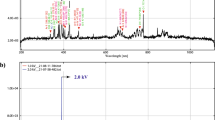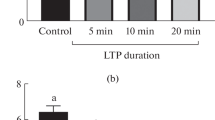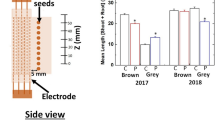Abstract
The current report is a continuation of our ongoing studies on the effect of cold plasma treatment on the physical and the biochemical properties of the Ocimum basilicum (sweet basil). Our previous work in this area revealed an enhanced growth effect by plasma treatment as well as higher levels of antioxidant components present in the essential oil extracts recovered from the plasma-treated plants. In the present study, the sweet basil was grown from seeds under controlled conditions with the plants separated into four groups. The first Group A (GA) is a control group where no plasma treatment was applied. In the second Group B (GB), the cold plasma treatment was applied to the seeds only. For Group C (GC-1X) and Group D (GD-2X), in addition to the seed treatment, the growing plants in these two groups received an additional body treatment, which was applied once (for Group C) and twice (for Group D) (weekly), following a standard treatment protocol. The total growing period was 14 weeks at which point the plants were harvested. Results revealed that the plants treated with plasma showed increased growth in their leaves and stems particularly in the later stages of vegetation. The essential oils from the sweet basil were recovered by Soxhlet extraction, and their composition was analyzed quantitatively by GC-FID and GC–MS. The extracts of the essential oil both in the control and plasma-treated plant groups showed five major components: eucalyptol, linalool, estragole, eugenol, and methyl cinnamate. Estragole was found to be in the highest concentration in the leaves, while linalool was the dominant product in the flowers, followed by estragole, eugenol, eucalyptol, and methyl cinnamate. In general, plasma treatment resulted in a significant increase in the concentration of both the estragole and linalool in the leaves, while lower concentrations of these two components were registered in the flowers for the plasma-treated groups.
Graphical abstract










Similar content being viewed by others
Data Availability Statement
This manuscript has associated data in a data repository. [Authors’ comment: This manuscript has no associated data or the data will not be deposited. The datasets generated during and/or analyzed during the current study are available from the corresponding author on reasonable request.]
References
J.Y. Tong, X.L. Zhang, R.T. Zhan, W.W. Chen, S.Z. Yang, Effects of atmospheric pressure air plasma pretreatment on the seed germination and early growth of Andrographis paniculata. Plasma Sci. Technol. 16(3), 260–266 (2014)
R. Amorati, M.C. Foti, L. Valgimigli, Antioxidant activity of essential oils. J. Agr. Food Chem. 61(46), 10835–10847 (2013)
L. Valgimigli, Essential oils: an overview on origins, chemistry, properties and uses, in Essential Oils as Natural Food Additives. ed. by L. Valgimigli (Nova Science Publishers, New York, 2012), pp.1–24
B.M. Lawrence, A further examination of the variation of Ocimum basilicum L. in Flavors and Fragrances, in B.M. Lawrence, B.D. Mookerjee, B.J. Willis (Eds.) Proceedings of the 10th International Congress on Essential Oils, Fragrances, and Flavors: A World Perspective, Washington, DC, USA, 16–20 November 1986; Elsevier: Amsterdam, The Netherlands; pp. 161–170. ISBN 9780444429643 (1988)
T.V. Koutsos, P.S. Chatzopoulo, S.T. Katsiotis, Effects of individual selection on agronomical and morphological traits and essential oil of a “Greek basil” population. Euphytica 170, 365–370 (2009)
D. Beatovic, D. Kristic-Milosevic, S. Trifunovic, J. Siljegovic, J. Glamoclija, M. Ristic, S. Jelcic, Chemical composition, antioxidant and antimicrobial activities of the essential oils of twelfe Ocimum basilicum L. cultivars grown in Serbia. Rec. Nat. Prod. 9, 62–75 (2015)
E. Klimakova, K. Holadova, L. Hajslova, T. Cajka, J. Poustka, M. Koudela, Aroma profiles of five basil (Ocimum basilicum L.) cultivars grown under conventional and organic conditions. Food Chem. 107, 464–472 (2008)
K. Seidler-Lozykowska, D. Krol, The content of essential oil in ten sweet basil (Ocimum basilicum L.) cultivars and its composition. Herba Pol. 54, 7–12 (2008)
E. Svecova, The study of Ornamental Species and Varieties of Ocimum L and their content matters. Diploma Thesis, Faculty of Horticulture in Lednice, Mendel University, Brno, Czech Republic (2006)
M. Marotti, R. Piccaglia, E. Giovanelli, Differences in essential oil composition of basil (Ocimum basilicum L.) Italian cultivars related to morphological characteristics. J. Agric. Food Chem. 14, 3926–3929 (1996)
R. Nurzynska-Wierdak, B. Borowski, K. Dzida, G. Zawislak, R. Kowalski, Essential oil composition of sweet basil cultivars as affected by nitrogen and potassium fertilization. Turk. J. Agric. For. 37, 427–436 (2013)
A. Murarikova, A. Tazky, J. Neugebauerova, A. Planlova, J. Jampilek, P. Macaji, P. Mikus, Characterization of essential oil composition in different basil species and pot cultures by a GC-MS method. Molecules 22, 1221 (2017)
T. Juntachote, E. Berghofer, Antioxidative properties and stability of ethanolic extracts of holy basil and Galangal. Food Chem. 92(2), 193–202 (2005)
G.J. Buonopane, C. Antonacci, J. Lopez, Effect of cold plasma processing on botanicals and their essential oils. Plasma Med. 6(3–4), 315–324 (2016)
V.S. Johnson, W.D. Zhu, R. Wang, J.L. Re, S. Sivaram, J. Mahoney, J.L. Lopez, A cold atmospheric-pressure helium plasma generated in flexible tubing. IEEE Trans. Plasma Sci. 39(11), 2360–2361 (2011)
K. Homa, W.P. Barney, W.P. Davis, D. Guerrero, M.J. Berger, J.L. Lopez, C.A. Wyenandt, J.E. Simon, Cold Plasma treatment strategies for the control of Fusarium oxysporum f. sp. basilici in Sweet Basil. HortScience 56(1), 42–51 (2021)
S. Auguste, The Effects of Cold Plasma Treatment on Sweet Basil (Ocimum basilicum). Seton Hall University Dissertations and Theses. https://scholarship.shu.edu/dissertations/2584/ (2018)
W. Davis, Plasma Agriculture: characterization of DBD plasma jet and analysis of effects when treated on Sweet Basil (Ocimum basilicum). Seton Hall University Dissertations and Theses. https://scholarship.shu.edu/dissertations/2912/ (2021)
B. Péret, G. Li, J. Zhao, L.R. Band, Auxin regulates aquaporin function to facilitate lateral root emergence. Nat. Cell Biol. 14, 991–998 (2012)
H. Kim, D. Jayasena, H. Yong, C. Jo, Quality of Cold Plasma Treated Foods of Animal Origin, Cold Plasma Food Agric., 2016, pp. 273–291
B.G. Bareja, “The Plant Stem, Functions, Parts and Classifications”, 2010, http://www.cropsreview.com/plant-stem.html, Accessed Mar 15, 2018
Acknowledgements
This research was partially supported by a University Research Council (URC) grant from Seton Hall University and patronage from the Academy for Green Chemistry, Stewardship, and Sustainability at Seton Hall University. The authors wish to acknowledge and thank Prof. Nicholas Snow of the Department of Chemistry and Biochemistry at Seton Hall University, who provided feedback and served along with G.P. and J.L. on the thesis evaluation committee of the successful Master’s Thesis completion of Sauvelson Auguste. We would also like to acknowledge and thank Dr. Mary J. Berger for her help and advice with the plant care.
Author information
Authors and Affiliations
Contributions
All authors contributed equally to the research and preparation of the present article.
Corresponding author
Ethics declarations
Conflict of interest
The authors declare no conflicts of interest to disclose.
Additional information
Electron-Driven Processes from Single Collisions to High-Pressure Plasmas.
Guest editors: Jose L. Lopez, Michael Brunger, Holger Kersten.
Rights and permissions
Springer Nature or its licensor (e.g. a society or other partner) holds exclusive rights to this article under a publishing agreement with the author(s) or other rightsholder(s); author self-archiving of the accepted manuscript version of this article is solely governed by the terms of such publishing agreement and applicable law.
About this article
Cite this article
Auguste, S., Buonopane, G.J., Tanielyan, S. et al. Effects of cold plasma treatment on growth enhancement and on the chemical composition of sweet basil plants (Ocimum basilicum). Eur. Phys. J. D 77, 64 (2023). https://doi.org/10.1140/epjd/s10053-023-00633-5
Received:
Accepted:
Published:
DOI: https://doi.org/10.1140/epjd/s10053-023-00633-5




